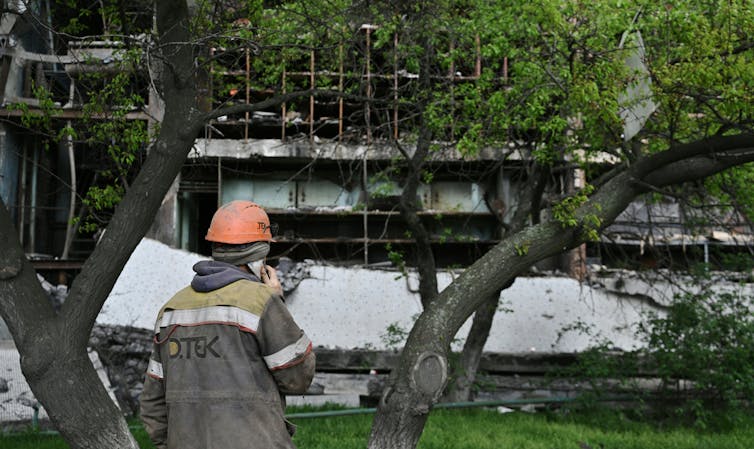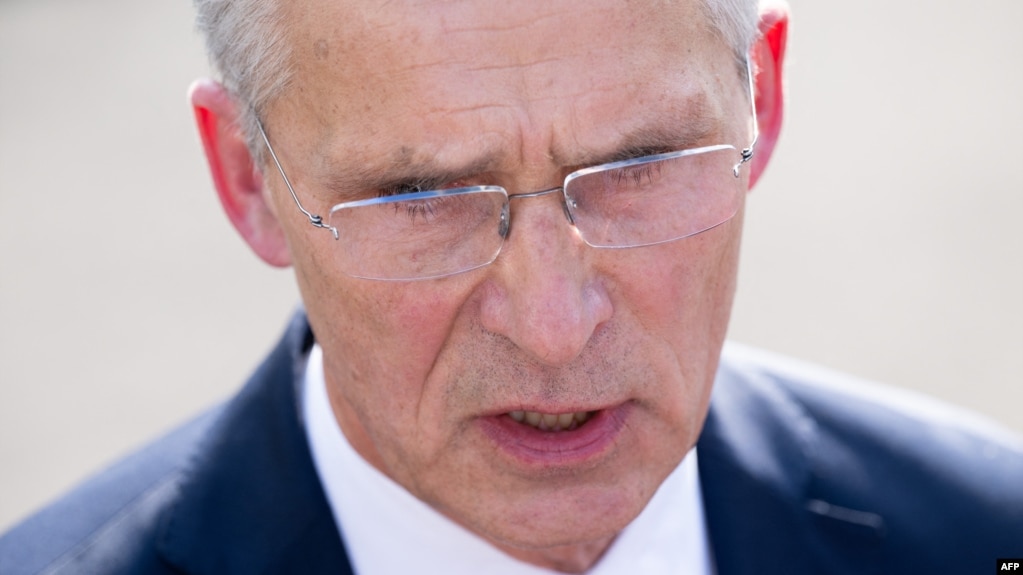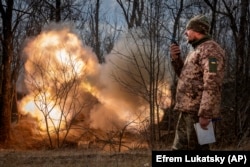NATO Chief: West Should 'Impose A Cost' On China For Its Support Of Russia
WASHINGTON -- NATO Secretary-General Jens Stoltenberg said on June 17 that China was providing technology to Russia that is prolonging its full-scale invasion of Ukraine and called on Beijing to face the consequences of this support.
"Beijing cannot have it both ways. At some point -- and unless China changes course -- allies need to impose a cost. There should be consequences," Stoltenberg said at the Wilson Center in Washington.
Live Briefing: Russia's Invasion Of Ukraine
RFE/RL's Live Briefing gives you all of the latest developments on Russia's full-scale invasion, Kyiv's counteroffensive, Western military aid, global reaction, and the plight of civilians. For all of RFE/RL's coverage of the war in Ukraine, click here.
Stoltenberg said that in the past two years 90 percent of Russian microelectronics originated in China, and that China was working to improve Russian satellite capabilities.
"Threats are not regional," Stoltenberg said. "China is fueling the largest armed conflict in Europe since World War II, and at the same time it wants to maintain good relations with the West."
White House National Security Council spokesman John Kirby also said China was continuing to provide Russia with components for military equipment and weapon systems.
Speaking at a briefing on June 17, he said microelectronics had helped "shore up...what would have been a truly crumbling Russian defense industrial base." Kirby added that the United States had raised the issue with China.
Stoltenberg noted that NATO faces threats from China related to Russia along with threats from China related to the Indo-Pacific and the Arctic.
Russia has also built up relations with North Korea, and on June 17 the Kremlin announced that President Vladimir Putin will embark on a two-day visit to North Korea starting on June 18. Putin is expected to meet North Korean leader Kim Jong Un for talks focused on expanding military cooperation.
The deepening relationship is a concern for the United States, Kirby said.
"We know North Korean ballistic missiles are being used to hit Ukrainian targets," he said.
Both Pyongyang and Moscow have denied accusations about North Korean weapons transfers, which would be in violation of UN Security Council resolutions.
Stoltenberg said the "growing alignment between Russia and its authoritarian friends in Asia makes it even more important that we work closely with our friends in the Indo-Pacific."
Non-NATO members Australia, Japan, South Korea, and New Zealand will attend the July 9-11 NATO summit in Washington as observers.
The secretary-general said Russia's ongoing war against Ukraine will be the "most urgent topic" for discussion at the summit, along with NATO defense spending.
Subscribe To RFE/RL's 'The Rundown'
Get a curated digest of all our essential news, features, and analysis, plus our best visual journalism, in your inbox every day. The Rundown keeps you up-to-date on Russia's ongoing invasion of Ukraine and developments across our vast coverage area. Sign up here.
Stoltenberg said he will announce new defense-spending figures for NATO allies later on June 17 when he meets U.S. President Joe Biden.
"This year, more than 20 allies spent at least 2 percent of GDP on defense," Stoltenberg said, previewing the announcement.
The increase in defense spending has bolstered Ukraine's defense capabilities, according to Stoltenberg, adding that the path to peace is more weapons for Ukraine.
Defense spending by many European countries has risen sharply since Russia's full-scale invasion of Ukraine in February 2022 and NATO officials have been keen to stress that its European members are now stepping up to the plate.
Although Ukraine will not become a member of the alliance at the Washington summit, Stoltenberg said NATO will "build a bridge" to future membership for Ukraine and praised the NATO-Ukraine Council set up last year at the summit in Vilnius.
"We are helping to ensure that the Ukrainian armed forces are more and more interoperable with NATO, meet NATO standards, and meet NATO doctrines," Stoltenberg said. "The idea is to move them so close to membership that when we reach a consensus, we can make them members straight away."
In his remarks at the Wilson Center, Stoltenberg did not mention earlier comments reported by The Telegraph that NATO is in talks to deploy more nuclear weapons.
The British newspaper quoted Stoltenberg as saying that the weapons would be taken out of storage and placed on standby.
Kremlin spokesman Dmitry Peskov called the comments "nothing but another escalation of tension," saying they appeared to contradict the communique of the Ukraine Conference that said any threat or use of nuclear weapons in the Ukraine context was inadmissible.
The price of rebuilding Ukraine goes up each day − but shirking the bill will cost even more -
The World Bank estimates the cost of rebuilding Ukraine at over $480 billion
U.S. military assistance is finally on its way to Ukraine after months of being held up in Congress.
Reactions to the US$61 billion spending package, signed into law by President Joe Biden on April 24, 2024, have ranged from applause to indignation.
While few people could deny it includes ammunition and equipment that Washington’s besieged Eastern European ally sees as crucial in its war with Russia, critics of the package say that money is better spent on domestic priorities.
But if that $61 billion seems like a lot to spend now, it’s nothing compared with what will be needed in the months and years to come.
Europeans, get our weekly newsletter with analysis from European scholars
The World Bank estimates the cost of rebuilding Ukraine at over $480 billion – around eight times the amount Congress authorized in the latest round of U.S. military aid.
That tremendous sum reflects the fact that postwar recovery is a complex, expensive process. But, as someone who studies the economics of conflict and recovery, I believe it’s a process in which the U.S. must be involved. There are compelling humanitarian and strategic reasons for America to help rebuild postwar Ukraine – even if it comes at a high price.
Rebuilding infrastructure
Achieving long-term stability in Ukraine will require political, social and economic recovery. Money is needed for everything from rebuilding hospitals and recovering farmland to removing land mines and reopening schools.
At the center of any postwar reconstruction effort, however, is infrastructure. Robust, well-functioning infrastructure is essential for providing basic services such as housing, energy and transportation. It’s also the scaffolding that supports economic recovery.

Infrastructure’s critical importance is precisely why it’s so often targeted during war. Destroying factories, bridges and power plants thwarts a country’s warfighting capacity. At the same time, it undermines a government’s ability to offer basic public services. It’s no surprise, then, that Russia has systematically attacked Ukraine’s transportation networks and energy production since the start of the invasion.
The damage has been catastrophic. An estimated $100 billion worth of infrastructure was destroyed in the war’s first month alone. Now, as the conflict enters its third year, at least half of the country’s energy grid and one-third of its transportation networks have been damaged as a result of Russian attacks.
And the situation continues to escalate. Drone and missile strikes throughout early 2024 have been aimed directly at Ukrainian power generation and distribution, reducing energy companies’ output by up to 80% and leaving nearly 2 million people without power.
The result is not just a political and economic crisis but also a humanitarian one. Lost power, along with damage to medical and educational facilities, has contributed to the massive displacement of more than 13 million people from areas where they can no longer receive daily necessities such as food, power and health care. The United Nations’ refugee agency estimates that no less than 40% of the country needs urgent humanitarian support.
The cost of not investing
Ending the war won’t end Ukraine’s crisis. Aggressive investment is needed. Any failure to fully invest in reconstruction risks deepening social strife, threatening the rule of law, depressing economic growth and undermining faith in democratic institutions.
Put simply, failing to repair a country’s infrastructure leads to longer-term instability.
Of course, U.S. opponents of spending money abroad may remain unswayed by arguments over the benefit to Ukraine’s economy. But they may be more persuaded by the potential financial impact to both the global and U.S. economies.
In today’s interconnected world, instability somewhere can hurt countries everywhere, especially when that “somewhere” is Ukraine – a central hub of energy distribution and food production, having provided 10% of the world’s grain prior to the conflict.
The past few years have laid bare the invasion’s broader economic and strategic implications. The war drove inflation by sending energy prices upward in Europe, dampening economic growth across the continent and resulting in enormous budgetary obligations to manage the shock at home.
In countries less able to absorb these shocks, such as Egypt and Tanzania, price hikes exacerbated problems of food insecurity and hindered local agricultural production by reducing supplies of vital fertilizers from Russia.
In short, the economic opportunity costs of the war are even greater than the costs of recovery. And failing to invest sufficiently in postwar recovery will widen this gap even further.
Encouraging investment
That all said, coming up with the half-trillion dollars the World Bank estimates for Ukraine’s recovery will not be easy.
Recognizing Ukraine’s mounting needs, the European Union pledged over $50 billion in support in early 2024, in addition to what it had committed already, while the the Group of Seven leading democratic economies, or G7, promised another $40 billion. Those commitments are significant, given that the G7’s official development assistance averages about $120 billion a year for all projects around the world.
Some of this money goes into efforts under the World Bank’s Ukraine Relief, Recovery, Reconstruction and Reform Trust Fund, which in turn falls under the World Bank’s broader Multi-Donor Resources for Institutions and Infrastructure for Ukraine program.
The World Bank’s Ukraine trust fund focuses specifically on critical infrastructure repairs such as roads and housing.
These programs could prove essential to Ukraine’s reconstruction but are unlikely in themselves to be enough. Quadrupling the G7’s average commitments of $120 billion a year still wouldn’t cover Ukraine’s bills, and it wouldn’t leave anything for needs elsewhere around the world.
Governments simply do not have the money – never mind the political will – to meet Ukraine’s critical needs.
But there are things that still can be done to help cover costs. The first, hardest option is an end to the war. The swelling costs of reconstruction, which increase with each day of fighting, should provide even more reason for outside countries to push for peace. This does not have to mean settling all the difficult territorial questions, which will probably require unpalatable compromises on both sides. But short of a full, lasting settlement, even temporary cease-fires can, at a minimum, limit additional economic damage.
Ending the fighting also mitigates the risk that currently deters private investment in Ukraine.
Foreign investment in Ukraine fell a precipitous 96% from 2021 to 2022 because of the uncertainty created by the war. Yet private capital represents an untapped resource capable of co-funding critical infrastructure projects.
G7 development agencies, along with multinational development banks, can lessen the financial burden by aggressively pursuing co-financing arrangements and additional risk guarantees to mobilize the private sector. Doing so could help close the widening gap between what Ukraine needs and what governments can offer.
Ultimately, then, NATO governments don’t have to assume all the financial responsibility of rebuilding Ukraine. But failing to mobilize more financial assistance, and leaving Ukraine in a cycle of instability, may end up costing much more.





No comments:
Post a Comment